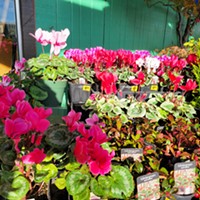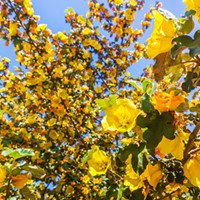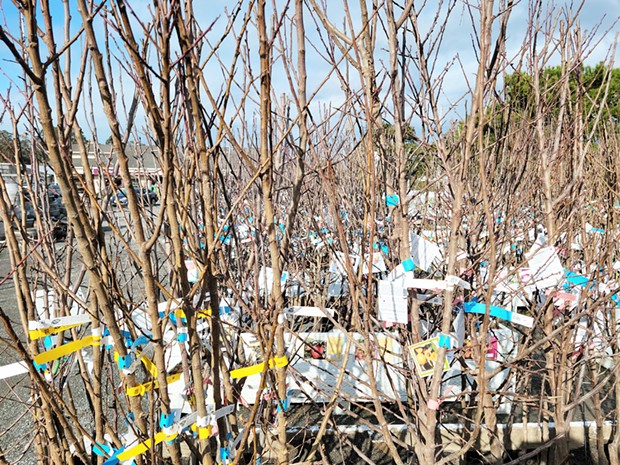[
{
"name": "Top Stories Video Pair",
"insertPoint": "7",
"component": "17087298",
"parentWrapperClass": "fdn-ads-inline-content-block",
"requiredCountToDisplay": "1"
}
]
If you've been to a local nursery lately, you've probably noticed a bunch of boxed stick-like things in sand or soil. Bare root tree/berry season is finally here. Why buy bare root instead of trees or items in pots? First, it's usually cheaper. Second, they tend to have a wider variety of bare root than potted items. It's also a great time to plant and get those (bare) roots established for spring and summer growth.
I usually buy one or two new trees or berry canes to put in my orchard and/or garden, though I'm sort of running out of room for more trees, despite picking semi-dwarf varieties.
Ever wondered what all that information is on the tag attached to the tree? Before I started doing this professionally, I mostly ignored the information, only to find out that my Gala apple didn't produce very well and I had no idea why.
Let's start with the description at the top of the tag. Most producers will tell you important details about the fruit, like a Liberty apple. You can see what the apple is good for (eating, baking, etc.), as well as any disease resistance. The tag lists when it typically produces fruit and the "chill hours," which indicates the number of hours the tree requires temperatures to be below 45 degrees to produce fruit. Here on the North Coast, we have cool summers, with mild winters, so our chill hours typically fall between 400-600 hours. Some winters, such as this one, we experience much colder nights for longer periods, so that adds to the hours available for chilling those trees. Inland areas tend to have more chill hours, since it can be much colder than here on the coast during a normal winter.
The last piece of information that always confused me as a novice gardener was the recommendation for what to plant with it. The Liberty apple tree is a good neighbor/pollinator for Red delicious, Empire and McIntosh apples. But why? Well, because they tend to bloom around the same time. If you go by any larger apple orchard such as Cledennan's in Fortuna or Fieldbrook Winery up in Fieldbrook, you'll see some trees in bloom, while others are fully leafed out. In other words, not all trees bloom at the same time. The same is true for plums, Asian pears, peaches and other stone fruits. One of my pruning clients wondered why his apple tree always bloomed but he had yet to get any fruit. Turns out he had only planted one apple, so unless someone nearby has a pollinator tree that blooms at the same time, he'll never get fruit on that tree, despite plentiful blooms and plenty of pollinators such as honeybees or bumblebees. A good pollinator for many apples is a crabapple. Even the ornamental ones bloom profusely for a long period of time, and the bees, wasps and flies that pollinate the blossoms will visit all trees in bloom, spreading the pollen to the other tree(s). But if you'd rather only have fruit producing trees, look at the tag and see what variety is recommended. You will also see the terms "self-fruitful," "self-fertile" or "partly self-fruitful." They mean the tree is a good pollinator for itself and doesn't need any other variety to be able to produce fruit.
The last thing to take into consideration when it comes to fruit trees is the rootstock on which it's grown. Most fruit trees are grafted, especially apples and pears. Why graft onto rootstock? If you plant a seed from an apple, you won't get the exact same apple variety, since the seed will show different characteristics from the original fruit. The way to have an identical fruit is to use a different rootstock, then graft a scion (a first year's growth twig from the mother tree) onto it. The fruit will be true and the size of the tree can be managed based on its type of rootstock. There are dwarf, semi-dwarf and full-sized/standard rootstocks. You can tell that the trees in bare root are grafted because there's a little "knuckle" toward the bottom of the trunk where the scion was grafted onto the rootstock. While you can prune for size, it's a lot easier to maintain a fruit tree if you select the size that is ideal for your planting area.
It's not just fruit trees that are available as bare root, though. You can find many kinds of berries, including raspberries, currants, gooseberries and blackberries. I know, why would anyone actually buy a blackberry plant when many of us battle blackberry brambles in our yards and gardens? Because you can get some delicious berries you can maintain much more easily. I'm a big fan of tayberries, which are a cross between a red raspberry and a blackberry. The fruits are much larger than a loganberry, which is also a cross between the same berry plants, but it produces a bigger and sweeter fruit.
Now that you've picked out your new trees and berries, it's time to get them in the ground. If it's rained recently, wait for the soil to dry out a few days, otherwise you can compact the soil and the roots can't spread as easily. If you need to wait for planting, you can heel them in, which is a way of saying, "plant in a temporary spot so the roots are covered but don't forget it's there." Especially that last part. Happy planting!
Julia Graham-Whitt (she/her) is owner and operator of the landscaping business Two Green Thumbs.
Speaking of...
-

Winter Planting for Future Color
Dec 21, 2023 -

A Gardener's Resolutions
Jan 6, 2022 -

A Bevy of Blueberries
Nov 25, 2021 - More »
Comments
Showing 1-1 of 1
more from the author
-
Working it Out in the Garden
- Jan 18, 2024
-
Winter Planting for Future Color
- Dec 21, 2023
-
Equinoctial To-Do and Native Plants
- Sep 21, 2023
- More »
































